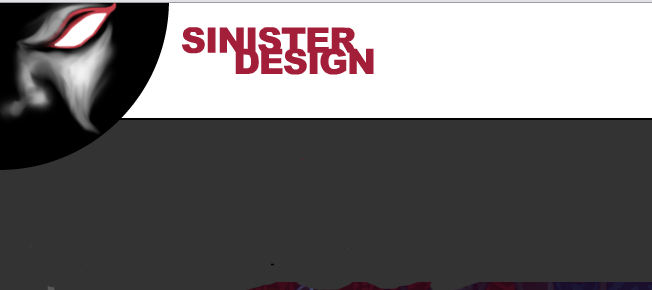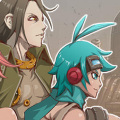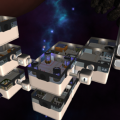The appeal of fantasy is undeniable. The truly memorable worlds and stories are those that are familiar enough to make us feel at home, but fresh enough to offer something new. Empyrios: Prophecy of Flame offers that. Gorgeous artwork, a vibrant world, extensive lore and intriguing story all provide the setting for an exciting party-based tactical RPG. We managed to catch up with Joe Woynillowicz, the company founder as well as game producer and developer, to find out a little more about the game world and the challenges behind a project of this scope.
Zane: Let me start the formal interview process by thanking you for taking the time to have this chat. I really appreciate it.
Joe: I definitely appreciate your time.
Zane: Founding a studio and creating a game of this scope aren’t small tasks by any means. What made you decide to become an indie developer, and found your studio?
Joe: Well I basically learned to write code about 19 years ago or so and started with writing BBS door games and moving on from there. I’ve worked at a few studios here in Toronto and in San Diego but eventually found myself working in other industries. The core game and ideas for Empyrios is actually a design I’ve been toying with for probably 4-5 years before the actual start of development and something that I’ve wanted to build for a long time.
Zane: Ah! Admittedly, I was curious which came first: Empyrios, or Creoterra.
Joe: Creoterra was really born in order to focus attention on building the types of games that we really wanted to play, to be honest. The core ideas and gameplay definitely predate us striking out and founding the studio, and we had a lot of world design and gameplay mechanics to start with. Once we found Jove—our artist—and he came on board with the project, is when things really started to come together from both a design and aesthetic point of view
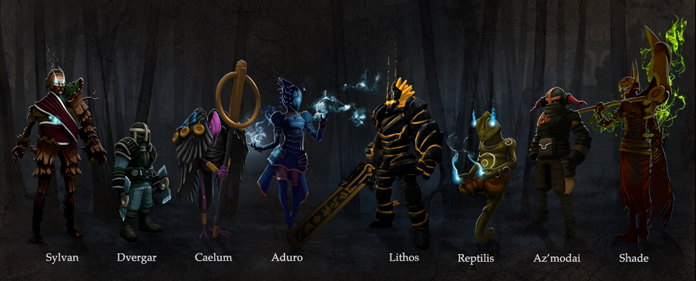 Zane: Your aesthetic does have that old-school fantasy game feel. There are a number of areas where you’re doing things differently. For instance, I notice you’re not going with the traditional fantasy races. Even the dvergar as ‘dark dwarves’ in concept are very rarely seen compared to, say, dark elves.
Zane: Your aesthetic does have that old-school fantasy game feel. There are a number of areas where you’re doing things differently. For instance, I notice you’re not going with the traditional fantasy races. Even the dvergar as ‘dark dwarves’ in concept are very rarely seen compared to, say, dark elves.
Joe: Well that was one thing that we really spent a lot of time on because we really wanted to create a new world for the game to take place in. We do have a human race, the Aduro, and then the Dvergar as you mentioned, but we really wanted to have a fresh feel rather than sticking with ‘old proven’ so we’ve tried to come up with a lot of different concepts. Jove was also a big part of this and we worked very well going between art and design. One example would be the ‘Shade’ race, which our original design had more as a traditional type of undead. Jove wanted to try something new and he took the backstory of them being outcast for refusing to stop playing with necromancy and other dark arts, and tied it into the overall race. So now instead of having, say, the usual skeletal minions you might see elsewhere, the shade are basically a humanoid spirit, but with various parts of different types of living beings kind of moulded together.
Zane: Even the Aduro have a unique feel compared to the tried-and-tested staple of Humans. It’s great to see all these unique options. I can’t resist, though: are there any races that are developer favourites?
Joe: We’ve really tried to give all races, and the entire world for that matter, a really unique feel both through art style and ability design. Regarding favourites I can say that the Lithos are quite popular and we usually feature the Brute character out of game, but beyond that everyone seems to have their own favourite to play. I play a lot of the Caelum (avian race) myself and would definitely say they’re one of my personal favourites. Some people like sticking mainly with one race in their team composition, but a lot of people actually like to select from various races in whichever faction they’re playing.
Zane: I’m glad that you came to the topic of factions. You probably get this question a lot, but what is the Prophecy of Flame, and how does it relate to the two factions and their agenda?
Joe: Well the Prophecy of Flame actually stems from the Aduro race but has ramifications across the world. The human race in this part of the world started to have visits from very strange humans from other lands. They spoke of Pyrios, the god of flame, and began to recruit others into their religion and follow their beliefs. This had huge ramifications as once the Aduro Nation became the largest sect, they went from a passive view to being more aggressive, and banning and outlawing various forms of magic. This is what led to the Shade, as they are actually exiled Aduro who wanted to continue their research and practice into the darker arts. Whether that was a good idea or not is yet to be seen. I can’t go into the actual prophecy itself, as I don’t want to spoil the plot of either campaign, but it encompasses the entire world and story.
Zane: No worries! We wouldn’t want to spoil any surprises. The two factions, the Mystic Covenant and the Shadowlord Pact, they’re then centred around the Aduro and Shade, and their positions regarding Pyrios and his word?
Joe: Well their battle is one component, but every race actually has their own goals in mind, and they the factions are alliances of purpose and convenience. One example is how during their exile a high mage of the Shade actually created the Lithos race through necromancy and spirit magic. This impacts the Dvergar as you now have these wild destructive creations born in the mountains who start attacking the mines and trade routes. On the other hand, you have the Caelum who have forged a pact with the Sylvan to protect the wooded lands, and by making it seem as if the Reptilis attacked them first they’ve drawn the Sylvan into their battle. The Prophecy of Flame also foretold of the ‘beasts from the desert’ which later emerge as the Az’Modai, something the story goes into in more detail. So really the factions are actually created out of necessity, trickery, or something in between. They are much looser than say a conventional alliance where different races are friends for no reason, and it’s always been that way.
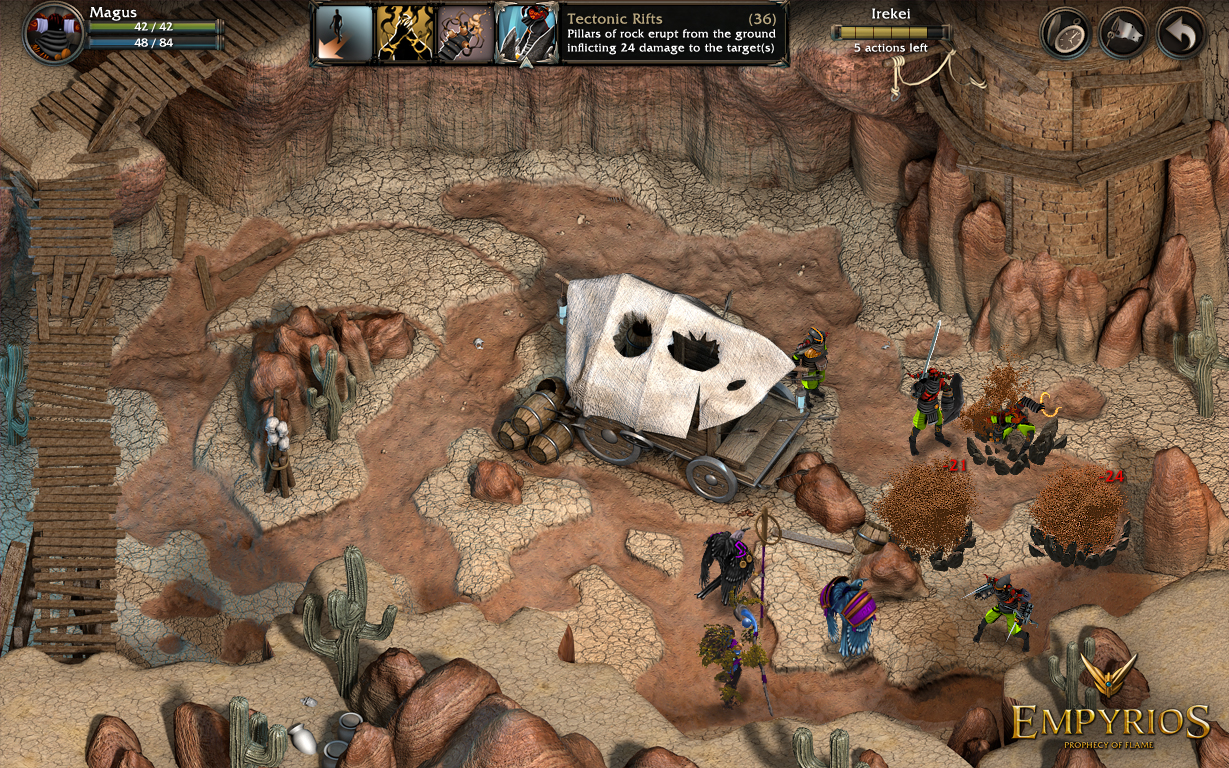 Zane: Wow. Suffice to say, there’s been a lot of preparation and fore-thought. All of this no doubt creates a rich back-story to set the current campaign’s events against.
Zane: Wow. Suffice to say, there’s been a lot of preparation and fore-thought. All of this no doubt creates a rich back-story to set the current campaign’s events against.
Joe: Each faction’s campaign story isn’t actually just a linear point A to point B narrative. Sometimes you might have 2-3 options open to you on the map and you have to make a decision. Do you help the Dvergar town or the Aduro town, or do you ignore both to support the Sylvan on the front lines in the forest? Each campaign is different depending on the choices you make and the outcomes of the battle.
Zane: Strategizing well is clearly a big part of the game, and using your environment to your advantage is a core component thereof. What are some of the key elements of Empyrios’ tactical combat?
Joe: Well you hit on one key component which is trying to take tactical advantage by using the environment. Some units can set traps or alter the environment in small ways. To that effect. map control and positioning is pretty big. Another is that each unit has a set of 3 skills that vary in power cost, so you have to decide on whether you want to use ability X now, or wait and use something that costs less until you can get into a better position for a larger ability. Ouside of the battles the units in your army gain levels, have a skill mastery tree, and even one additional customization system that we’re still working on. So just because an enemy is using a Lithos Brute, you can’t be sure if he’s using it as a traditional ‘tanky’ type build, crowd control, or focussing on raw damage. And of course setting up team synergy and combos and planning your strategy is something that gives a nice edge.
Zane: Wow. Multiple campaigns with non-linear story-lines and player controlled outcomes, and then full control in a tactical environment with a myriad of options…have to say, you guys have put a lot of thought, effort and passion into this project.
Joe: Yeah it’s actually been quite the undertaking! As I mentioned early the core game concept and ideas were coming together for years before development started (actually using HeroQuest miniatures on a cardboard map), and we’ve been in full production for quite an insane amount of time.
Zane: What have been some of the major challenges of going Indie and working on Empyrios?
Joe: Well the biggest challenge for me has been the switch over to production. I spent the majority of my career, both in and out of games, in software engineering and technical direction. So while I worked hand in hand with producers, artists, and designers, I was still heavily tech focused. I had a million and one things to learn, and a lot of mistakes to make, but having someone like Jove on the project was absolutely huge as he took care of the aesthetic direction and really helped bring this idea and story on paper to life. Also, scope was a huge issue as the amount of work was pretty staggering on all fronts, whether it be code, design, art, anything! Although on a positive note we knew going into the project that it wasn’t something we would be building quickly and that we were in for the long haul project… so it wasn’t like we were surprised or hammered by scope creep.
Zane: I can imagine with something like an RPG, where you have to cater for every individual player contingency, as well as test to ensure the combinations are compatible, that it’s a huge undertaking.
Joe: The testing is actually a major part, especially with the team composition and customization. I build a lot of in-house tools and we’ve basically had bots playing the game 24/7 against each other for over a year constantly collecting data. It was quite fun, actually, because the bots were building teams and combos based on statistical analysis. Quite a few times the AI created some monster teams where we immediately knew we had to go in and fine-tune some abilities. The bots came up with a few team compositions that we never would have dreamed of using… but if the AI found them, players definitely would have at some point.
Zane: In that case, mental note to self: only play against other humans. You mention a variety of game modes, including the campaign and multiplayer. What are the modes on offer for the release?
Joe: We have the campaign mode, which is has a full non-linear campaign for each faction individual faction. Then there’s online multiplayer, local multiplayer, and practice. With online games we have a full infrastructure and matchmaking system so you can play ‘ranked’ games or just friendly games against friends. There are even unlockables and achievements. Local multiplayer is just what it sounds like: multiple friends against each other, playing on the same device. Practice mode is essentially local multiplayer versus bots.
Zane: Whom we’ve just established might be much nastier than your friends, depending on your difficulty level (and friends).
Joe: Hehehe very true.
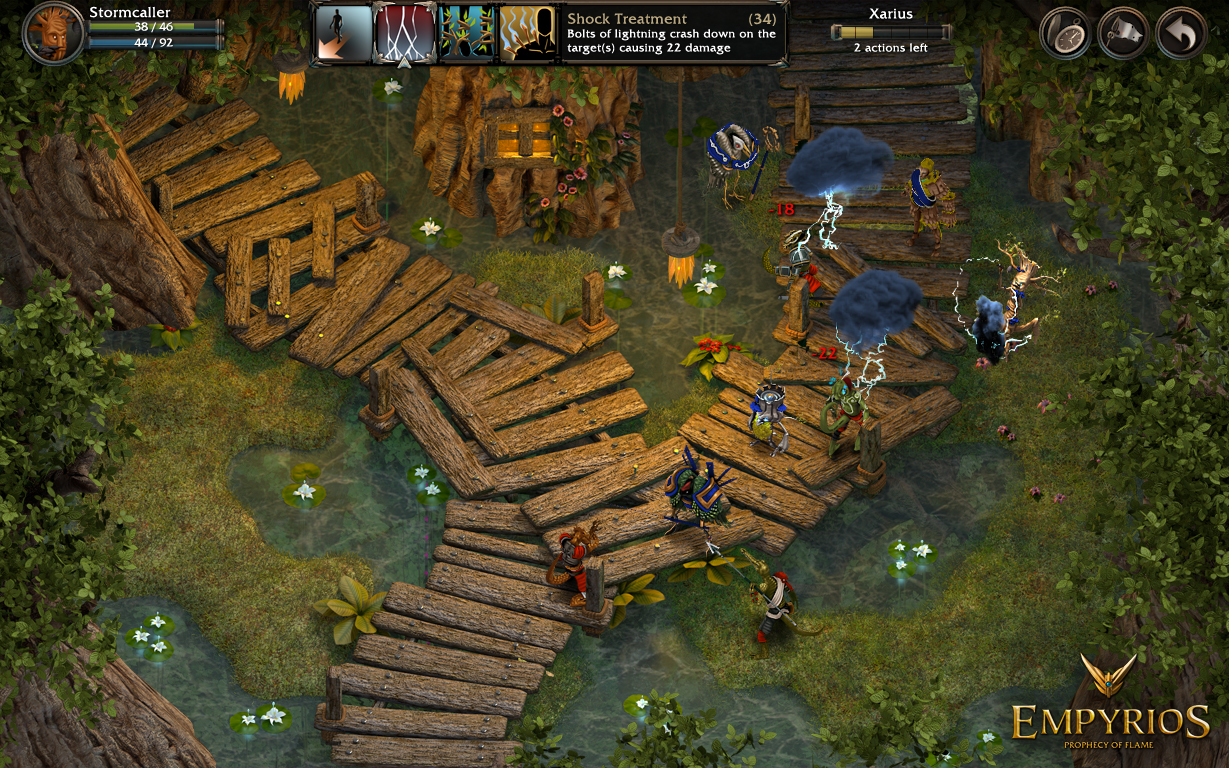 Zane: I know this is probably your least favourite question as a developer, but the journalist code of honour dictates that I ask. Without us forcing you to commit to it, do you have a rough release date in mind?
Zane: I know this is probably your least favourite question as a developer, but the journalist code of honour dictates that I ask. Without us forcing you to commit to it, do you have a rough release date in mind?
Joe: Well our target is Q4 this year, but depending on development we may run into Q1 of next year. We’re actually 100% art complete at this stage (and we’re working on the first update actually), and majority code complete. Right now a lot of the work is in continuing to work on unit balancing, story/campaign, and heavy polishing across the board. Of course no promises with time as we want to make sure everything is extremely polished and as perfect as we can build it in our view.
Zane: That’s exciting news! Is there any way our readers can help show their support or keep up to speed with the latest progress reports and news?
Joe: Well we always massively appreciate support on Twitter and Facebook which we’ll be updating with news much more often. We’ve been ‘working in a dark cave’ for the last about 5 weeks while trying to get our latest alpha build ready and in testing so we haven’t had the stream of updates I’d like to see but there will be a lot more in the coming weeks. Also we’re hoping to have both the empyrios.com website and steam green light page online within the next 3-4 weeks or so. And of course players can check our company site where there is more information on the game and will be continually updated
Zane: Thank you very much, Joe. Do you have any final words of advice or inspiration you’d like to share with any aspiring indie devs who might be reading?
Joe: Well for me I think the biggest thing is that if you have a great game idea that you’d like to realize, you have to build it. In some cases, like with Empyrios, the design morphed from tabletop gameplay builds over the years, and writing the backstory as a hobby, into building out the entire game in production. Just be very mindful that if you haven’t produced a AAA or indie title in the past, you are going to learn a million new things, your time estimates will be derailed, and you’ll probably hit a host of unforeseen problems. As we’re wrapping up development on Empyrios I am definitely really happy with the overall process and what we’ll have achieved in the end, and I hope that players will feel the same way.
© 2014, The Indie Mine. All rights reserved.

